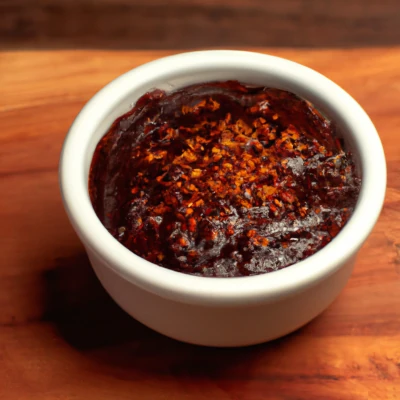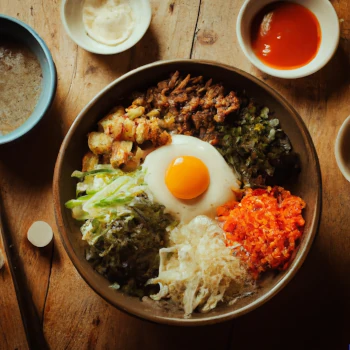Spicy Peanut Sauce

Savor the culinary traditions of South Asia with Granny's favorite Peanut Sauce recipe. This sauce, a staple in many Indonesian households, has found a cherished place many families' meals, loved by both children and adults alike. Its unique blend of ingredients, each thoughtfully selected, creates a rich, flavorful sauce that is a testament to the diverse and vibrant flavors of South Asian cuisine.
This peanut sauce owes its irresistible appeal to a combination of simple ingredients, thoughtfully selected for their unique contributions to the overall flavor profile. The honey, peanut butter, and soy sauce are carefully blended with herbs and spices, allowing for a rich, flavorful sauce in every bite. As if that wasn't enough, we also add a touch of heat with crushed red pepper flakes. The result is an explosion of flavor that keeps everyone reaching for more! Perfect as a soothing dinner on a quiet evening or as an indulgent side dish during the holidays, this peanut sauce promises to dazzle your taste buds and warm your heart. Its comforting embrace, carried forth in each savory spoonful, is a testament to the power of home-cooked food to deliver love and happiness in its most delicious form.

Ingredients
¼ cup honey ⅓ cup smooth peanut butter 2 tablespoons soy sauce 2 tablespoons rice vinegar 2 tablespoons extra-virgin olive oil 1 tablespoon sesame oil 2 teaspoons minced fresh garlic 1 tablespoon minced fresh ginger root 1 teaspoon crushed red pepper flakes ½ cup coconut milk
Method
- 1. In a small bowl, combine the honey, peanut butter, soy sauce, rice vinegar, olive oil, and sesame oil. Stir these ingredients until they are well blended and the mixture is smooth.
- 2. Add the minced fresh garlic, minced fresh ginger root, and crushed red pepper flakes to the mixture. Stir again to ensure these ingredients are evenly distributed throughout the sauce.
- 3. Gradually add the coconut milk, stirring continuously. Start with a small amount and continue adding until you reach your desired consistency. Remember, you can always add more coconut milk if you prefer a thinner sauce. Once the sauce is to your liking, it's ready to be served!

Spicy Indonesian Peanut Sauce
Serving this peanut sauce is all about simplicity and versatility. It's traditionally used as a dipping sauce for spring rolls or satay, as a dressing for salads, or as a sauce for noodles. For a heartier dish, consider using it in a stir-fry or as a sauce for grilled chicken or tofu. Don't forget to garnish with a sprinkle of freshly chopped cilantro or a handful of crushed peanuts for an authentic touch. No matter how you choose to serve it, this peanut sauce is sure to elevate your meal with its rich, robust flavor.
For an extra kick of heat and depth of flavor, consider incorporating sambal into this peanut sauce recipe. Sambal is a spicy chili paste or sauce that originates from Indonesian and Malaysian cuisine. It typically consists of a variety of chili peppers ground together with secondary ingredients such as shrimp paste, fish sauce, garlic, ginger, shallots, and lime juice. Adding a tablespoon or two of sambal to your peanut sauce will introduce a complex layer of heat and umami, enhancing the overall taste profile. The fiery notes of sambal complement the creamy, nutty flavors of the peanut sauce, creating a more authentic and robust Southeast Asian flavor. Experiment with different types of sambal, such as sambal oelek (a raw chili paste) or sambal bajak (a sweeter, cooked version), to find the perfect balance for your palate.
Peanut sauce, the ultimate comfort food, has a rich history and a special place in the hearts of many. Whether enjoyed as a simple side dish or elevated to a gourmet creation, this savory delight has captured the taste buds of people worldwide. Let's delve into the fascinating history of peanut sauce, explore different variations, and share some creative ideas to spice up this beloved dish.
Peanut sauce can trace its origins back to Southeast Asia, where a version of this dish was enjoyed as early as the 16th century. The sauce gained popularity in the West during the 20th century, thanks to the influence of traveling chefs and the growing interest in international cuisine.
In the United States, peanut sauce emerged as a staple in the late 20th century, when it was introduced in Thai and Indonesian restaurants. Its unique flavor and versatility quickly made it a favorite among food lovers.
The traditional peanut sauce recipe consists of peanut butter simmered with herbs and spices. Garlic and ginger are the most commonly used ingredients due to their aromatic flavor, but variations with other ingredients like coconut milk or lime juice can offer exciting twists. Baked versions, where the sauce is used as a base for dishes like satay or stir-fry, add a delightful depth of flavor.

Serving Suggestions for Spicy Peanut Sauce
Spicy Peanut Sauce is traditionally served over rice and a protein, such as chicken or tofu, enhancing these simple ingredients with its rich, nutty flavor and velvety texture. Its balance of savory, sweet, and spicy notes makes it a perfect companion for various dishes. One of the most popular uses is as a marinade or finishing sauce for grilled meat skewers, where it creates a delightful contrast between the smoky, charred exterior and the creamy, indulgent sauce. However, its culinary versatility extends far beyond these traditional pairings, making it a must-have ingredient in any kitchen.
- Drizzle over stir-fries – Elevate a mix of sautéed vegetables, tofu, or chicken with a generous pour of this flavorful sauce.
- Use as a salad dressing – Thin the sauce slightly with coconut milk or lime juice to create a creamy, tangy dressing for fresh greens or grain-based salads.
- Serve as a dipping sauce – Enjoy it with spring rolls, dumplings, crispy tofu, or even roasted vegetables for a punch of umami.
- Incorporate into wraps and sandwiches – Spread it inside a wrap or drizzle over grilled meats for a bold, nutty accent.
- Pair with noodles – Toss it with rice noodles or spaghetti for a quick and delicious peanut noodle dish.
Granny’s beloved Peanut Sauce has deep roots in the culinary traditions of Indonesia, a country renowned for its bold and diverse flavors. In Indonesia, peanut sauce, or 'Sambal Kacang,' is a staple component of many dishes, offering a balance of spice, sweetness, and creaminess that complements a variety of foods. Traditionally, this sauce is most commonly associated with satay, a popular street food of skewered and grilled meat served with a generous drizzle of peanut sauce. But the sauce’s adaptability has led to its widespread use in other beloved Indonesian dishes:
- Gado-Gado – A vibrant Indonesian salad made of blanched vegetables, boiled eggs, tofu, and tempeh, all brought together with a rich peanut dressing.
- Ketoprak – A comforting vegetarian dish featuring rice cakes, rice vermicelli, tofu, and bean sprouts, topped with peanut sauce for a satisfying meal.
- Pecel – A Javanese dish of steamed vegetables smothered in a slightly spicier version of peanut sauce.
The journey of this luscious sauce beyond Indonesia is a testament to its universal appeal. It found a new home in the Dutch culinary scene, a development deeply rooted in the historical context between the Netherlands and Indonesia. The Netherlands colonized Indonesia for several centuries, a period during which Indonesian cuisine significantly influenced Dutch food culture. This era of colonial rule, while marked by exploitation and conflict, also led to the exchange and adaptation of culinary traditions.
Over time, Dutch cuisine embraced the bold and complex flavors of Indonesian cooking, incorporating them into everyday meals. One of the most notable adaptations is Indonesian peanut sauce, which in the Netherlands is commonly known as 'Pindasaus.' Unlike its traditional Indonesian counterpart, which is often spicier and more textured, Dutch-style peanut sauce is typically milder and smoother. Today, it is a beloved condiment in the Netherlands, often served with:
- Fries – A favorite Dutch snack, frequently accompanied by a side of creamy peanut sauce for dipping.
- Babi Pangang – A dish featuring roasted pork with a fusion of Indonesian and Dutch influences, often served with peanut sauce.
- Kroketten and Bitterballen – Dutch fried snacks that pair beautifully with a side of peanut sauce for extra richness.
Whether you're savoring it in its authentic Indonesian form, exploring its Dutch fusion, or indulging in an Americanized version, Spicy Peanut Sauce offers a culinary experience like no other. Its luxurious texture and complex flavor profile make it a standout addition to any dish. No matter how you choose to enjoy it—drizzled over grilled meats, tossed into a salad, or simply used as a dip—this peanut sauce is sure to elevate your meal with its irresistible combination of sweetness, savoriness, and spice.

Related Recipes
-

Gochujang
Homemade Gochujang (고추장) is a spicy Korean chili paste made from glutinous rice, fermented soybeans, and red chili pepper flakes. Perfect for adding flavor and kick to Korean dishes like bibimbap, marinating meats, or enhancing soups.
-

General Tao’s Sauce
Granny’s General Tao’s Sauce is a kitchen essential for your homemade Chinese cuisine. This delightful sauce combines sweet, spicy, and tangy flavors that would elevate your stir-fried dishes, dumplings, egg rolls, and more.
-

Bibimbap
A delightful Korean rice dish topped with an assortment of seasoned vegetables, gochujang (spicy Korean chili paste), and your choice of protein such as beef, chicken, or tofu. It's a harmonious blend of flavors and textures.